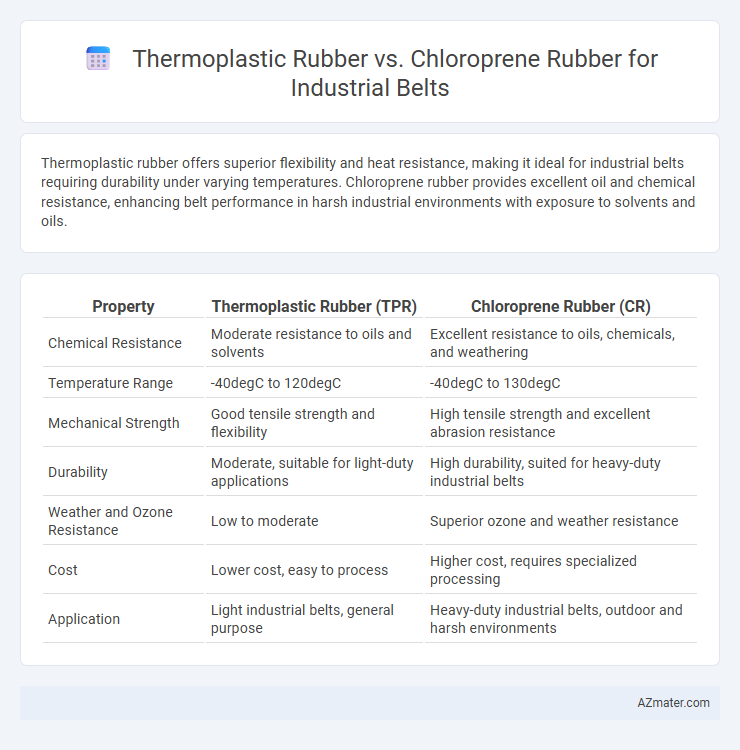Thermoplastic rubber offers superior flexibility and heat resistance, making it ideal for industrial belts requiring durability under varying temperatures. Chloroprene rubber provides excellent oil and chemical resistance, enhancing belt performance in harsh industrial environments with exposure to solvents and oils.
Table of Comparison
| Property | Thermoplastic Rubber (TPR) | Chloroprene Rubber (CR) |
|---|---|---|
| Chemical Resistance | Moderate resistance to oils and solvents | Excellent resistance to oils, chemicals, and weathering |
| Temperature Range | -40degC to 120degC | -40degC to 130degC |
| Mechanical Strength | Good tensile strength and flexibility | High tensile strength and excellent abrasion resistance |
| Durability | Moderate, suitable for light-duty applications | High durability, suited for heavy-duty industrial belts |
| Weather and Ozone Resistance | Low to moderate | Superior ozone and weather resistance |
| Cost | Lower cost, easy to process | Higher cost, requires specialized processing |
| Application | Light industrial belts, general purpose | Heavy-duty industrial belts, outdoor and harsh environments |
Introduction to Industrial Belt Materials
Thermoplastic rubber (TPR) offers excellent flexibility, chemical resistance, and ease of molding, making it suitable for industrial belt applications requiring dynamic movement and durability. Chloroprene rubber (CR), known for its superior weather resistance, oil tolerance, and mechanical strength, excels in harsh environments with exposure to oils, chemicals, and extreme temperatures. Choosing between TPR and CR depends on specific industrial belt requirements, including environmental conditions, load capacity, and operational lifespan.
Overview of Thermoplastic Rubber (TPR)
Thermoplastic Rubber (TPR) offers superior flexibility, excellent abrasion resistance, and easy processability, making it ideal for industrial belt applications requiring durability and repetitive motion tolerance. Unlike Chloroprene rubber, TPR provides excellent cold resistance and recyclable material benefits, contributing to sustainable manufacturing practices. Its blend of thermoplastic and elastomeric properties enables efficient molding and consistent performance across diverse industrial environments.
Properties of Chloroprene Rubber (CR)
Chloroprene rubber (CR) offers exceptional resistance to oil, heat, and weathering, making it ideal for industrial belt applications requiring durability and longevity. Its excellent tensile strength and good elasticity allow it to withstand mechanical stress and maintain performance under varying environmental conditions. Furthermore, CR exhibits strong chemical resistance and flame retardancy, enhancing safety and reliability in heavy-duty industrial settings.
Durability Comparison: TPR vs Chloroprene Rubber
Thermoplastic rubber (TPR) offers enhanced flexibility and resistance to abrasion, making it suitable for industrial belt applications requiring moderate durability and repeated flexing. Chloroprene rubber (neoprene) demonstrates superior chemical resistance, excellent resilience against oils, heat, and ozone, providing longer service life in harsh industrial environments. In terms of durability, chloroprene rubber typically outperforms TPR by maintaining structural integrity under extreme conditions and prolonged mechanical stress.
Chemical Resistance in Industrial Applications
Thermoplastic rubber (TPR) offers excellent resistance to a wide range of chemicals, including oils, acids, and alkalis, making it suitable for industrial belts exposed to harsh environments. Chloroprene rubber (CR), also known as neoprene, provides superior resistance to ozone, weathering, and moderate chemical exposure, especially to refrigerants and solvents. For industrial belt applications requiring high chemical resistance, TPR excels in aggressive chemical exposure, while chloroprene rubber performs better where durability against environmental factors is also critical.
Temperature Performance: TPR vs CR
Thermoplastic rubber (TPR) generally operates effectively within a temperature range of -50degC to 120degC, providing moderate heat resistance ideal for light to medium industrial applications. Chloroprene rubber (CR), also known as neoprene, exhibits superior temperature performance, withstanding continuous use from -40degC up to 130degC and intermittent spikes to 150degC, making it suitable for demanding environments involving heat exposure. The enhanced thermal stability of CR ensures better durability and longer service life for industrial belts subjected to fluctuating or elevated temperatures.
Flexibility and Mechanical Strength
Thermoplastic rubber (TPR) offers superior flexibility and elasticity compared to chloroprene rubber, making it ideal for applications requiring repeated bending and movement in industrial belts. Chloroprene rubber, however, exhibits greater mechanical strength, tensile strength, and abrasion resistance, which enhance durability under heavy load and harsh industrial environments. Selecting between TPR and chloroprene rubber for industrial belts depends on balancing the need for flexibility with resistance to mechanical stress and wear.
Cost Analysis and Economic Efficiency
Thermoplastic rubber (TPR) generally offers lower initial costs and faster manufacturing times compared to chloroprene rubber, making it more economically efficient for large-scale industrial belt production. Chloroprene rubber, while higher in upfront expense due to superior chemical resistance and durability, reduces long-term maintenance and replacement costs, benefiting heavy-duty applications. Analyzing total cost of ownership, TPR suits cost-sensitive projects, whereas chloroprene rubber delivers better economic value in environments demanding higher performance and longevity.
Suitability for Specific Industrial Environments
Thermoplastic rubber (TPR) offers excellent flexibility and chemical resistance, making it ideal for industrial belts used in environments with frequent exposure to oils and abrasives. Chloroprene rubber (CR), known for its superior heat resistance and weather stability, suits belts operating in high-temperature or outdoor industrial settings where durability against ozone and UV exposure is critical. Choosing between TPR and CR depends on specific environmental demands such as temperature extremes, chemical exposure, and mechanical stress.
Conclusion: Choosing the Right Rubber for Industrial Belts
Thermoplastic rubber (TPR) offers superior flexibility, ease of processing, and excellent resistance to abrasion and chemicals, making it ideal for industrial belts requiring high durability and frequent operational adjustments. Chloroprene rubber (CR) provides enhanced resistance to oil, heat, and weathering, suited for belts operating in harsh environments with exposure to extreme temperatures and aggressive substances. Selecting the right rubber depends on specific industrial conditions, balancing TPR's adaptability and cost-efficiency against CR's robustness in demanding settings.

Infographic: Thermoplastic rubber vs Chloroprene rubber for Industrial belt
 azmater.com
azmater.com